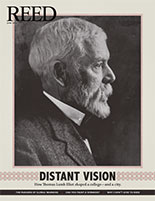
IRIS login | Reed College home Volume 93, No. 2: June 2014
Reediana
Return to the Land of the Head Hunters: Edward S. Curtis, the Kwakwaka’wakw, and the Making of Modern Cinema
(Seattle, University of Washington Press, 2014)
Coedited by Aaron Glass ’94

Romanticized depictions of Native Americans as noble savages or remnants of a dying race dominate popular conceptions of the continent’s indigenous people, even today. In anthropology and art history, analyzing this “vanishing savage” mythos has gone hand in hand with a greater privileging of voices of native people themselves. Aaron Glass has made major contributions to this discussion, notably in 2010 with The Totem Pole: An Intercultural History (coedited with Aldona Jonaitis). In a new book, Glass and coeditor Brad Evans turn to ethnographic film—in particular In the Land of the Head Hunters, a 1914 silent documentary about precontact rites of the Kwakwaka’wakw (“Kwakiutl”) Indians of coastal British Columbia. Its director, Edward S. Curtis, had already become world-famous for photographic portraits of American Indians. For decades, Head Hunters was lost, and we read here the story of its rediscovery, its reexamination, and a dramatic screening in Alert Bay, B.C., where it had been shot, and where Kwakwaka’wakw people, including descendants of the film’s actors and advisers, provided new soundtrack and commentary.
Like most of his contemporaries, Curtis assumed he was recording something on the brink of vanishing entirely. To be fair, many Kwakwaka’wakw of his day would also be surprised if they could see, today, the extent to which their traditions have survived the juggernaut of missionization, economic exploitation, boarding schools, and criminalization of their central potlatch ceremonies. Curtis also seemed confident he could capture an untainted, pure, precolonial way of life—even as he staged scenes, swapped costumes back and forth, and took pains to keep trappings of modernity like European-style buildings and ships out of shot.
The benefit of hindsight tempts us to dismiss Curtis’ naïveté or his fetishization of authenticity. But the many voices brought together here—art historians both native and non-native, activists, anthropologists, even a renowned modern Kwakwaka’wakw documentary filmmaker—reach for a more nuanced critical appreciation of the film’s legacy. Though as much a colonial as an indigenous artifact, it also contains “true” ethnographic data, albeit of a mediated kind. While the arrogance of Curtis’ “salvage ethnography” project rankles modern sensitivities, it is undoubtedly a valuable record of an intercultural encounter, observer and observed. Curtis’ romanticism and its pernicious subtext—that recording tribal cultures is necessary because preserving them is futile or foolish, and that such recording is a white privilege—are rightly seen as part and parcel of colonialism. One Tsimshian art historian refers in this volume to Curtis “frantically trying to capture the ‘disappearing Indian’ by shooting us with his colonial weapon of choice—the camera.” But as Glass, Evans, and their contributors show, Curtis and his native collaborators have left something that can be bent to new uses as a bulwark against cultural erasure.

LATEST COMMENTS
steve-jobs-1976 I knew Steve Jobs when he was on the second floor of Quincy. (Fall...
Utnapishtim - 2 weeks ago
Prof. Mason Drukman [political science 1964–70] This is gold, pure gold. God bless, Prof. Drukman.
puredog - 1 month ago
virginia-davis-1965 Such a good friend & compatriot in the day of Satyricon...
czarchasm - 4 months ago
John Peara Baba 1990 John died of a broken heart from losing his mom and then his...
kodachrome - 7 months ago
Carol Sawyer 1962 Who wrote this obit? I'm writing something about Carol Sawyer...
MsLaurie Pepper - 8 months ago
William W. Wissman MAT 1969 ...and THREE sisters. Sabra, the oldest, Mary, the middle, and...
riclf - 10 months ago